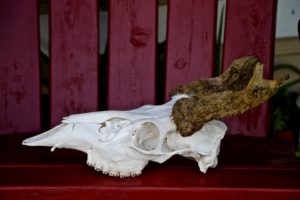Fanged Whitetails?
[author] [author_image timthumb=’on’]https://www.biggame.org/wp-content/uploads/2019/10/untamed.png[/author_image] [author_info]Larry Weishuhn is a widely known writer, speaker, raconteur and world hunter. He co-hosts “DSC’s Trailing the Hunter’s Moon” on Pursuit Channel, CarbonTV and the show’s YouTube Channel.[/author_info] [/author]
Several hunters were standing around looking intently at a heavy-bodied, mature whitetail buck laying on Texas Parks and Wildlife Department scales at a Webb County Deer Check Station. All deer taken in the county for a three-year period were required  to be brought to an official check station manned by a wildlife biologist to be weighed, aged, and have their antler measured. This, back in the previous century when quality deer management was in its infancy. “Larry, you need to see this!” said the wildlife technician who had opened the buck’s mouth. He looked at tooth wear to estimate the deer’s age, and he was now pointing at the buck’s upper jaw. I bent over for a closer look. There on the buck’s upper front jaw was a small canine looking tooth about the same place would one expect to find an elk’s bugling teeth. The toothy protrusion was about a quarter of an inch long and slightly narrower.
to be brought to an official check station manned by a wildlife biologist to be weighed, aged, and have their antler measured. This, back in the previous century when quality deer management was in its infancy. “Larry, you need to see this!” said the wildlife technician who had opened the buck’s mouth. He looked at tooth wear to estimate the deer’s age, and he was now pointing at the buck’s upper jaw. I bent over for a closer look. There on the buck’s upper front jaw was a small canine looking tooth about the same place would one expect to find an elk’s bugling teeth. The toothy protrusion was about a quarter of an inch long and slightly narrower.
 I reached to the other side of the upper jaw to determine if it too possessed an upper canine. It did not. From behind, I heard one of the hunters say, “That buck has got a fang!” Before I could respond he summoned ever more people to come and see what he loudly described as a “fanged whitetail”!
I reached to the other side of the upper jaw to determine if it too possessed an upper canine. It did not. From behind, I heard one of the hunters say, “That buck has got a fang!” Before I could respond he summoned ever more people to come and see what he loudly described as a “fanged whitetail”!
Hunters stared in amazement, “Never seen anything like it!” “Think it’s some sort of a cross between a deer and javelina?” “Must be a devil deer!” I smiled.
When comments slowed, I stood up. “Actually that “fang” is called an “upper canine.” Probably a genetic throwback to an age many eons ago, when most whitetail deer likely had them. Tiy can see these sorts of teeth or tusks in some of the old world deer such as red stag, sika deer, and even our elk. Some of the Asiatic deer species such as muntjac have fairly long upper canines and antlers as well. There’s a Chinese water deer that has no antlers but they do have long upper canines. Thousands of years ago, deer diets were a likely different from today, plus bucks likely fought their own kind and predators with those elongated upper front teeth.”

“This makes the fourth whitetail buck I’ve seen with such teeth. Two of those had then on both sides and the other had only one like this buck.” I continued, “From what research I have found, primarily it’s the bucks that have upper canines. Depending upon the researcher, only about one-one hundredths (0.01) to fourteen one-hundredths (0.14) of a percent of the whitetail bucks have such teeth. Frankly, it’s a pretty rare occurrence!” I suggested the hunter who shot the buck have a skull mount done, rather than a shoulder mount. That way he could show off his truly rare buck.
Years later, my youngest grandson, Andrew Johnson, shot an ancient velvet-horn buck (also know as a “cactus buck,” one that never sheds its velvet due usually to injury to the testicles) in the South Texas Brush Country. Andrew’s buck had quarter-inch upper canines on both sides, actually the longest I have seen.
This fall after you take your whitetail buck, be sure to check if it has upper canine teeth. Should they be present, know you have taken a truly rare deer, that is a genetic throwback to a long-ago bygone era!
 Regardless of what is going on in the world, there are always small things, of beauty and splendor, for us to enjoy, admire and appreciate!
Regardless of what is going on in the world, there are always small things, of beauty and splendor, for us to enjoy, admire and appreciate!
Watch “DSC’s Trailing the Hunter’s Moon” TV show on our YouTube Channel, or on CarbonTV.
If you haven’t heard any of the “DSC’s Untamed Heritage” podcasts, visit blubrry.com/untamedheritage/ to listen to one of our 30 podcast episodes.



